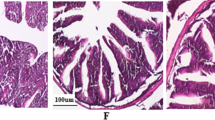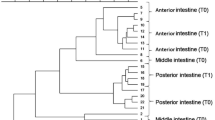Abstract
Gut microbiota of grass carp plays an important role in host. However, detailed information regarding the changes of microbiota after probiotics administration in relation to the gastrointestinal microbiota is absent. In the present study, dietary administration of putative probiotics Shewanella xiamenensis A-1, Aeromonas veronii A-7, and Bacillus subtilisstrains was conducted in grass carp to investigate if there is a discernible alteration in intestinal microbiota and whether the alteration is associated with previous study about the immunity regulation in grass carp. Bacterial 16S rRNA gene sequence-based comparisons of the bacterial communities in the grass carp intestine were detected after 28 days feeding by five diets, and results demonstrated the changes of microbial community composition at genus level. The abundance of Cetobacterium genus with potential immunity function increased. Potential pathogens and probiotics are important constitutions of the intestinal microbiota. Orally taken probiotics considerably reduced the abundance of the potential pathogenic bacteria (e.g., Pseudomonas and Flavobacterium genus) in the intestine. Meanwhile, putative probiotics used in this study were favorable to the reproduction of potential probiotics in THE intestine of grass carp (e.g., Vibrio, Streptococcus, and Enterococcus genus). Moreover, modulation of intestinal environment by the probiotics could impact the abundance of cellulose-degrading bacteria (e.g., Citrobacter genus). Those results suggested that oral probiotics administration can positively improve the composition of intestinal microbial community in grass carp, and this was associated with regulation of immunity in grass carp. Probiotics-induced alteration of microbiota may potentially lower the risk of disease outbreaks during cultivation stage of grass carp.





Similar content being viewed by others
References
Rawls JF, Samuel BS, Gordon JI (2004) Gnotobiotic zebrafish reveal evolutionarily conserved responses to the gut microbiota. P Natl Acad Sci USA 101:4596–4601
Nayak SK (2010) Probiotics and immunity: a fish perspective. Fish Shellfish Immunol 29:2–14
Wu SG, Wang GT, Angert ER, Wang WW, Li WX, Zou H (2012a) Composition, diversity, and origin of the bacterial community in grass carp intestine. PLoS One 7:e30440
Wu SG, Tian JY, Gatesoupe FJ, Li WX, Zou H, Yang BJ, Wang GT (2013) Intestinal microbiota of gibel carp (Carassius auratus gibelio) and its origin as revealed by 454 pyrosequencing. World J Microbiol Biotechnol 29:1585–1595
Ringø E, Olsen RE, Mayhew TM, Myklebust R (2003) Electron microscopy of the intestinal microflora of fish. Aquaculture 227:395–415
Wang GX, Liu YT, Li FY, Gao HT, Lei Y, Liu XL (2010) Immunostimulatory activities of BacillusSimplex DR-834 to carp (Cyprinus carpio). Fish Shellfish Immunol 29:378–387
Zadeh SS, Saad CR, Christianus A, Kamarudin MS, Sijam K, Shamsudin MN, Neela VK (2010) Assessment of growth condition for a candidate probiotic, Shewanella algae, isolated from digestive system of a healthy juvenile Penaeus monodon. Aquacult Int 18:1017–1026
Liu CH, Chiu CH, Wang SW, Cheng W (2012) Dietary administration of the probiotic, Bacillussubtilis E20, enhances the growth, innate immune responses, and disease resistance of the grouper, Epinephelus coioides. Fish Shellfish Immunol 33:699–706
Jiang HF, Liu XL, Chang YQ, Liu MT, Wang GX (2013) Effects of dietary supplementation of probiotic Shewanella colwelliana WA64, Shewanella olleyana WA65 on the innate immunity and disease resistance of abalone, Haliotis discus hannai Ino. Fish Shellfish Immunol 35:86–91
Chi C, Jiang B, Yu XB, Liu TQ, Xia L, Wang GX (2014) Effects of three strains of intestinal autochthonous bacteria and their extracellular products on the immune response and disease resistance of common carp, Cyprinus carpio. Fish Shellfish Immunol 36:9–18
Hao K, Liu JY, Ling F, Liu XL, Lu L, Xia L, Wang GX (2014) Effects of dietary administration of Shewanella haliotis D4, Bacillus cereus D7 and Aeromonas bivalvium D15, single or combined, on the growth, innate immunity and disease resistance of shrimp, Litopenaeus vannamei. Aquaculture 428-429:141–149
Giri SS, Sukumaran V, Sen SS, Jena PK (2014) Effects of dietary supplementation of potential probiotic Bacillus subtilis VSG1 singularly or in combination with Lactobacillus plantarum VSG3 or/and Pseudomonas aeruginosa VSG2 on the growth, immunity and disease resistance ofLabeo rohita. Aquaculture Nutr 20:163–171
Nayak SK, Swain P, Mukherjee SC (2007) Effect of dietary supplementation of probiotic and vitamin C on the immune response of Indian major carp, Labeo rohita (ham.) Fish Shellfish Immunol 23:892–896
Kumar R, Mukherjee SC, Ranjan R, Nayak SK (2008) Enhanced innate immune parameters in Labeo rohita (ham.) following oral administration of Bacillus subtilis. Fish Shellfish Immunol 24:168–172
Pieters N, Brunt J, Austin B, Lyndon AR (2008) Efficacy of in-feed probiotics against Aeromonas bestiarum and Ichthyophthirius multifiliis skin infections in rainbow trout (Oncorhynchus mykiss, Walbaum). J Appl Microbiol 105:723–732
Kong Y, Teather R, Forster R (2010) Composition, spatial distribution, and diversity of the bacterial communities in the rumen of cows fed different forages. FEMS Microbiol Ecol 74:612–622
Flint HJ, Bayer EA, Rincon MT, Lamed R, White BA (2008) Polysaccharide utilization by gut bacteria: potential for new insights from genomic analysis. Nat Rev Microbiol 6:121–131
Silva FC, Nicoli JR, Zambonino-Infante JL, Kaushik S, Gatesoupe FJ (2011) Influence of the diet on the microbial diversity of faecal and gastrointestinal contents in gilthead sea bream (Sparus aurata) and intestinal contents in goldfish (Carassius auratus). FEMS Microbiol Ecol 78:285–296
Pandit NP, Shen Y, Wang W, Chen Y, Li J (2013) Identification of TNF13b (BAFF) gene from grass carp (Ctenopharyngodon idella) and its immune response to bacteria and virus. Dev Comp Immunol 39:460–464
Han S, Liu Y, Zhou Z, He S, Cao Y, Shi P (2010) Analysis of bacterial diversity in the intestine of grass carp (Ctenopharyngodon idellus) based on 16S rDNA gene sequences. Aquac Res 42:47–56
Gao F, Li FH, Tan J, Yan JP, Sun HL (2014) Bacterial community composition in the gut content and ambient sediment of sea cucumber Apostichopus japonicusrevealed by 16S rRNA Gene pyrosequencing. PLoS One 9:e100092
Mohapatra S, Chakraborty T, Prusty AK, Das P, Paniprasad K, Mohanta KN (2012) Use of different microbial probiotics in the diet of rohu, Labeo rohita fingerlings: effects on growth, nutrient digestibility and retention, digestive enzyme activities and intestinal microflora. Aquaculture Nutr 18:1–11
Wu ZQ, Jiang C, Ling F, Wang GX (2015) Effects of dietary supplementation ofintestinal autochthonous bacteria on the innate immunity and disease resistance of grass carp (Ctenopharynodon idellus). Aquaculture 438:105–114
Wu ZX, Feng X, Xie LL, Peng XY, Yuan J, Chen XX (2012b) Effect of probioticBacillus subtilisCh9 for grass carp,Ctenopharyngodon idella(Valenciennes, 1844), on growth performance, digestive enzyme activities and intestinal microflora. J Appl Ichythyol 28:721–727
Li WF, Zhang XP, Song WH, Deng B, Liang Q, Fu LQ, Zheng JJ, Wang Y, Yu DY (2012) Effects of Bacillus preparations on immunity and antioxidant activities in grass carp (Ctenopharyngodon idellus). Fish PhysiolBiochem 38:1585–1592
Cutting SM (2011) Bacillus probiotics. Food Microbiol 28:214–220
Aly SM, Ahmed YAG, Ghareeb AAA, Mohamed MF (2008) Studies on Bacillus subtilis and Lactobacillus acidophilus, as potential probiotics, on the immune response and resistance of Tilapia nilotica (Oreochromis niloticus) to challenge infections. Fish Shellfish Immunol 25:128–136
Wu S, Gao T, Zheng Y, Wang W, Cheng Y, Wang G (2010) Microbial diversity of intestinal contents and mucus in yellow catfish (Pelteobagrus fulvidraco). Aquaculture 303:1–7
Edgar RC, Haas BJ, Clemente JC, Quince C, Knight R (2011) UCHIME improves sensitivity and speed of chimera detection. Bioinformatics 27:2194–2200
Edgar RC (2013) UPARSE: highly accurate OTU sequences from microbial amplicon reads. Nat Methods 10:996–998
Amato KR, Yeoman CJ, Kent AN, Righini N, Carbonero F, Estrada A (2013) Habitat degradation impacts black howler monkey (Alouatta pigra) gastrointestinal microbiomes. ISME J 7:1344–1353
Schloss PD, Gevers D, Westcott SL (2011) Reducing the effects of PCR amplification and sequencing artifacts on 16S rRNA-based studies. PLoS One 6:e27310
Wang Y, Sheng HF, He Y, Wu JY, Jiang YX, Tam NF, Zhou HW (2012) Comparison of the levels of bacterial diversity in freshwater, intertidal wetland, and marine sediments by using millions of illumina tags. Appl Environ Microbiol 78:8264–8271
Ni J, Yan Q, Yu Y, Zhang T (2014) Factors influencing the grass carp gut microbiome and its effect on metabolism. FEMS Microbiol Ecol 87:704–714
Qin J, Li R, Raes J, Arumugam M, Burgdorf KS, Manichanh C (2010) A human gut microbial gene catalogue established by metagenomic sequencing. Nature 464:59–65
Ventura M, Canchaya C, Tauch A, Chandra G, Fitzgerald GF, Chater KF, van Sinderen D (2007) Genomics of actinobacteria: tracing the evolutionary history of an ancient phylum. Microbiol Mol Biol Rev 71:495–548
Ni J, Yu Y, Zhang T, Gao L (2012) Comparison of intestinal bacterial communities in grass carp, Ctenopharyngodon idellus, from two different habitats. Chin J Oceanol Limnol 30:757–765
Tsuchiya C, Sakata T, Sugita H (2008) Novel ecological niche of Cetobacterium somerae, an anaerobic bacterium in the intestinal tracts of freshwater fish. Lett Appl Microbiol 46:43–48
Nikoskelainen S, Ouwehand AC, Bylund G, Salminen S, Lilius EM (2003) Immune enhancement in rainbow trout (Oncorhynchus mykiss) by potential probiotic bacteria (Lactobacillus rhamnosus). Fish Shellfish Immunol 15:443–452
Kim DH, Austin B (2006) Innate immune responses in rainbow trout (Oncorhynchus mykiss, Walbaum) induced by probiotics. Fish Shellfish Immunol 21:513–524
Liu H, Wang L, Liu M, Wang B, Jiang K, Ma S, Li Q (2011) The intestinal microbial diversity in Chinese shrimp (Fenneropenaeus chinensis) as determined by PCR–DGGE and clone library analyses. Aquaculture 317:32–36
Pond MJ, Stone DM, Alderman DJ (2006) Comparison of conventional and molecular techniques to investigate the intestinal microflora of rainbow trout (Oncorhynchus mykiss). Aquaculture 261:194–203
Verschuere L, Rombaut G, Sorgeloos P, Verstraete W (2000) Probiotic bacteria as biological control agents in aquaculture. Microbiol Mol Biol Rev 64:655–671
Chabrillon M, Rico RM, Balebona MC, Morinigo MA (2005) Adhesion to sole, Solea senegalensis Kaup, mucus of microorganisms isolated from farmed fish, and their interaction with Photobacterium damselae subsp. piscicida. J Fish Dis 28:229–237
Sugita H, Hirose Y, Matsuo N, Deguch Y (1998) Production of the antibacterial substance by Bacillus sp. strain NM 12, an intestinal bacterium of Japanese coastal fish. Aquaculture 169:269–280
El-Dakar AY, Shalaby SM, Saoud IP (2007) Assessing the use of a dietary probiotic/prebiotic as an enhancer of spinefoot rabbitfish Siganus rivulatus survival and growth. Aquaculture Nutr 13:407–412
Giri SS, Sukumaran V, Dangi NK (2012) Characteristics of bacterial isolates from the gut of freshwater fish, Labeo rohita that may be useful as potential probiotic bacteria. Probiotics AntimicroProt 4:238–242
Pandiyan P, Balaraman D, Thirunavukkarasu R, George EGJ, Subaramaniyan K, Manikkam S, Sadayappan B (2013) Probiotics in aquaculture. Drug Invention Today 5:55–59
Pankratov TA, Dedysh SN, Zavarzin GA (2006) The leading role of actinobacteria in aerobic cellulose degradation in Sphagnum peat bogs. Dokl Biol Sci 410:428–430
Acknowledgements
This research was supported by the Shaanxi Science and Technology Co-ordination and Innovation Project (NO. 2015KTTSNY01-02).
Author information
Authors and Affiliations
Corresponding authors
Ethics declarations
Conflict of Interest
The authors declare that they have no conflicts of interest.
Ethical Approval
Care of animals was in compliance with the guidelines of the Animal Experiment Committee, Northwest A&F University.
Rights and permissions
About this article
Cite this article
Hao, K., Wu, ZQ., Li, DL. et al. Effects of Dietary Administration of Shewanella xiamenensis A-1, Aeromonas veronii A-7, and Bacillus subtilis, Single or Combined, on the Grass Carp (Ctenopharyngodon idella) Intestinal Microbiota. Probiotics & Antimicro. Prot. 9, 386–396 (2017). https://doi.org/10.1007/s12602-017-9269-7
Published:
Issue Date:
DOI: https://doi.org/10.1007/s12602-017-9269-7




